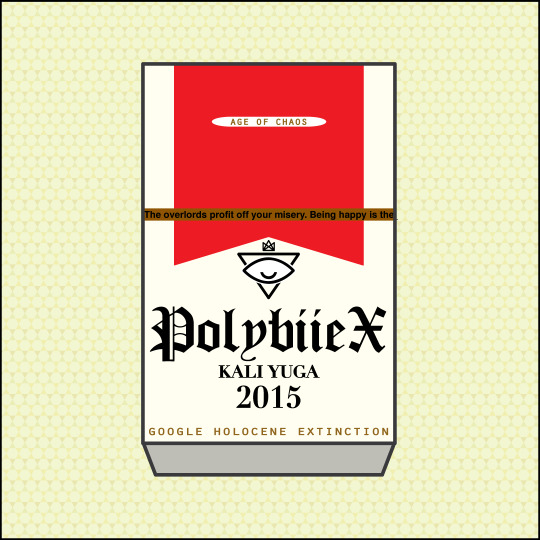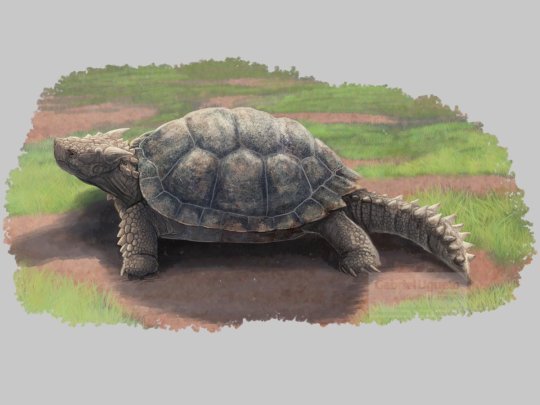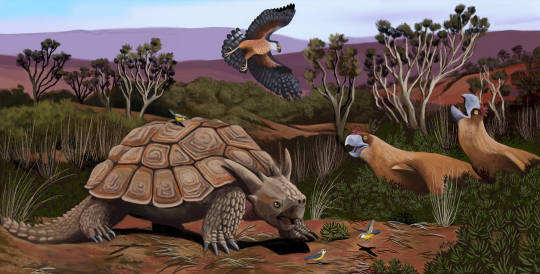#holocene extinction
Photo

The Second Extinction of the Pyrenean Ibex, a new nonfiction comic by me about humanity's quest to clone extinct animals and the time we almost-but-not-quite succeeded, is coming as part of Iron Circus Comics’ FAILURE TO LAUNCH anthology! Look for the crowdfunding campaign in early 2023.
#iron circus comics#pyrenean ibex#extinction#extinct species#conservation#holocene extinction#skeletons#cloning#zoology#indie comics#my artwork
474 notes
·
View notes
Text
"The biological and geological future of Earth can be extrapolated based on the estimated effects of several long-term influences. These include the chemistry at Earth's surface, the cooling rate of the planet's interior, the gravitational interactions with other objects in the Solar System, and a steady increase in the sun's luminosity. An uncertain factor is the pervasive influence of technology introduced by humans, such as climate engineering, which could cause significant changes to the planet. For example, the current Holocene extinction is being caused by technology, and the effects may last for up to five million years. In turn, technology may result in the extinction of humanity, leaving the planet to gradually return to a slower evolutionary pace resulting solely from long-term natural processes."
Wikipedia contributors, "Holocene extinction" (Sep 11, 2023).
#holocene extinction#extinction#biology#geology#environmentalism#climate crisis#technology#indexmiscellany
7 notes
·
View notes
Text

fancy a smoke?
#marlboro#marlboro reds#my art#digital art#cigarette#graphic design#holocene extinction#holocene#kali yuga#age of chaos#artists on tumblr#dystopia#gloomy#moody
5 notes
·
View notes
Text
#cats#octopuses#global warming#climate change#holocene extinction#nuclear war#nuclear winter#pandemic#global pandemic#animals#polls#pokemon go to the polls
12 notes
·
View notes
Text
the borderline incomprehensible horror of the number and scale of interconnected moral, environmental, and human health crises created by animal agriculture.
#veganism#climate change#environment#capitalism#leftism#holocene extinction#its literally the leading cause of the sixth mass extinction event i dont know how to get ppl to care if they dont care about this
3 notes
·
View notes
Video
The only known footage of the Laysan ʻapapane (Himatione fraithii) from 1923.
After rabbits were introduced and consumed their nectar sources, the Laysan ‘apapane went extinct alongside the Laysan millerbird and Laysan rail due to a strong storm that hit the island.
[video source]
2K notes
·
View notes
Text

Otus frutuosoi
Сан-Мігельська сова (Otus frutuosoi) — невелика вимерла сова, яка колись мешкала на острові Сан-Мігель, що на Макаронезькому архіпелазі Азорських островів, у північній частині Атлантичного океану.
Повний текст на сайті "Вимерлий світ":
https://extinctworld.in.ua/otus-frutuosoi/
#otus#owl#birds#san miguel#strigidae#azores#owls#aves#holocene#paleontology#paleoart#prehistoric#bird#illustration#palaeoblr#sciart#extinct#fossils#ukraine#ukrainian#digital art#article#палеоарт#палеонтологія#україна#мова#українська мова#арт#птахи#atlantic ocean
29 notes
·
View notes
Photo




Meiolania also known as the horned turtle, is an extinct genus of meiolaniid stem-turtle that lived throughout Australia, Lord Howe Island, New Caledonia, Vanuatu, and Fiji from the Middle Miocene to early Holocene some 20 mya to 2,000 years ago. The first fossil remains of Meiolania where uncovered from Lord Howe Island by Sir Richard Owen in 1886 who thought they represented ancient lizards and assigned the remains as belonging to two species M. platyceps and M. minor (now a synonym of the former), dubbing the genus Meiolania meaning small roamer. In time however it was learned that Meiolania was actually a terrestrial turtle and today 3 species are recognized: M. platyceps, M. mackayi, and M. brevicollis. Reaching 4 to 8 feet in length and 250-1,000lbs in weight, Meiolania is a candidate for the largest known terrestrial turtle/ tortoise, rivaled only by Megalochelys atlas from Pleistocene Asia. Meiolania had an unusually shaped skull that sported many knob-like and horn-like protrusions. Two large horns faced sideways, and would have prevented the animal fully withdrawing its head into its shell. Aside from the large spikes on the head, Meiolania also had a spiked tail similar to some tails of the ankylosaurus and glyptodonts, these may have been defensive features for protecting the head and tail extremities from predators as such adaptations would have made it difficult for predators to close their mouths around these spots without getting a mouthful of spikes. In life Meiolania would have inhabited Forests, Savannahs, and Wetlands feeding upon sedges, grasses, shrubs, flowers, cacti, fruit, and carrion. The disappearance of much of the Pleistocene megafauna is often attributed to the arrival of humans and in the case of Meiolania there is actually strong evidence to support this. In Vanuatu the remains of Meiolania have been found in the rubbish dumps of early human settlements, going extinct some three hundred years after the first human contact.
Art can be found here:
https://twitter.com/serpenillus/status/1264250510753890307
https://www.deviantart.com/hodarinundu/art/New-Caledonia-3000-years-ago-903959697
#meiolania#pleistocene pride#pleistocene#miocene#holocene#cenozoic#australia#new caledonia#extinct#turtle#tortoise#horned#horned tortoise
58 notes
·
View notes
Text
Geokichla longitarsus Hume, 2022 (new species)

(Select bones of Geokichla longitarsus [scale bars = 10 mm], from Hume, 2022)
Meaning of name: longitarsus = long [in Latin] foot [in Greek]
Suggested common name: Mauritius ground thrush
Age: Holocene (more precise age uncertain)
Where found: Vallée des Prêtres, Port Louis, Mauritius
How much is known: Several limb bones, including a tarsometatarsus (fused ankle and foot bones), humeri (upper arm bones), and tibiotarsi (fused shin and ankle bones). It is unknown whether any of these bones belonged to the same individuals.
Notes: Geokichla is a genus of thrushes from Afro-Eurasia, of which many species feed primarily on the ground. G. longitarsus is the first extinct species of Geokichla to be identified. In terms of skeletal anatomy, it was similar to but slightly larger than the extant orange-headed thrush (G. citrina) of Southern and Southeast Asia. G. longitarsus may have descended from Asian thrushes that reached Mauritius during a period when sea levels were lower than they are today, conditions that would have exposed more land in the island archipelagos of the Indian Ocean and made overseas crossings more manageable.
Over 60% of bird species unique to Mauritius are known to have gone extinct in recent times, including G. longitarsus. No firsthand observations of this thrush have been found in records of Mauritian fauna, so it is possible that it died out before the arrival of the Dutch (who wrote the oldest known accounts of the wildlife of Mauritius in the late 16th Century). The introduction of black rats by Arab traders in the 14th Century may have been what caused the extinction of G. longitarsus, as a small, ground-dwelling bird unfamiliar with mammalian predators would have probably been very vulnerable to rat predation.
Reference: Hume, J.P. 2022. A new subfossil ground thrush (Turdidae: Geokichla) from Mauritius, Mascarene Islands. Bulletin of the British Ornithologists' Club 142: 388–403. doi: 10.25226/bboc.v142i4.2022.a2
#Palaeoblr#Birblr#Dinosaurs#Birds#Geokichla longitarsus#Mauritius ground thrush#Holocene#Africa#Telluraves#2022#Extinct
18 notes
·
View notes
Photo

The final count is in: my upcoming comic "The Second Extinction of the Pyrenean Ibex" features **134** species of animals, mostly Holocene extinctions! That's an average of 13.4 species/page. Don’t let anyone tell you I’m not dedicated to the cause (animals).
This nonfiction comic about de-extinction technology is coming next year as part of Iron Circus Comic’s "Failure to Launch" anthology!
#my artwork#paleoblr#extinction#zoology#extinct species#paleoart#holocene extinction#conservation#animals#biodiversity
123 notes
·
View notes
Text
Highlight of the day: found a small land planarian (flatworm) in the sink. :] I have caught wayward leopard slugs wandered into the bath or sink a few times, but I've never seen a flatworm in person before today.
I know I'm in the minority but I genuinely love coming across unusual creatures or bugs in unexpected places like that? Recently we had a crayfish build a mound in a wet part of the yard which was like ??? I never even see them in creeks anymore, and I had no idea they could come that far inland (let alone that they built mounds)? Or many years ago I found a tiny pseudoscorpion (another animal I'd never even heard of) in a brand new apartment. It made me wonder what sort of environment that apartment complex had been originally to be home to something so unique.
It's a shame so many of the cool creatures we have on Earth are just considered pests to be eliminated :/
#not that i don't have any of my own hangups with wildlife esp arachnids...#but for the most part i enjoy sharing a world with so many interesting creatures#it's not their fault they get into people places sometimes. there are fewer and fewer natural habitats available :/#sucks ass being alive to witness the holocene extinction in real time#bullshit#personal
5 notes
·
View notes
Note
Pardon me, that bird book you posted about, can you share the name of it? I collect stuff related to Holocene Extinctions and would love a copy for my collection.
sure! its actually two:
the bachmans warbler is from A Field Guide to the Birds by Roger Tory Peterson (1947 edition)
and the ivory billed woodpecker is from The Giant Golden Book of Birds by Robert Porter Allen (1961)
theres also some others from some additions to the post, if youre interested:
passenger pigeon, from Report on the Birds of Pennsylvania by B. H. Warren (1888)
carolina parakeet, from Animate Creation by Rev. J. G. Wood (volume 3 or 4? 1885)
3 notes
·
View notes
Text
hmmm thinking about the ii world again
#i think about the evolutionary history of the ii world a lot#the main headcanon that i have had for the ii world is that the overall history of the world is the same as earth#minus the existence of humans#life goes on throughout the holocene but an extinction event happens a few million years later#a large percentage of life is decimated in this event with then leads to evolutionary radiation of the remaining organisms#in terms of terrestrial domination i like to think that avians and some reptiles start to become some on the major predators on the planet#as they start to fill the vacant niches left over by large mammals#mammals still exist btw#as well as arthropods#while avians and reptiles become some of the major predators on the planet#there is still stiff competition with the later evolutionary descendants of mammals on some of the continents of the world#also objects appear way later after all of this#basically what i am saying is that the ii verse has larger birds compared to modern ones#if you did read through this thank you for seeing my ramble about the speculative biology of an object show
3 notes
·
View notes
Text
hated tumblr blazed posts from the beginning but getting someone's blazed post of their pet serval is the final straw i think
3 notes
·
View notes
Text

Wild nature of Europe of the Holocene geological epoch
Wild nature of Europe of the Holocene geological epoch.
At the beginning of the Holocene, there were many more animals in the wild than there are now.
Today we have the opportunity to return them.
Large canvas wall art Wild nature of Europe of the Holocene geological epoch. Prehistoric animals wall art print for home decoration, teen girl room decor, shelf decor, gift for husband, grandma gift, retirement gifts, farewell gift.

Also, these paintings will help you in the design of a scientific gallery, museum exposition, educational presentation, scientific work, publication of a scientific article in a magazine.
You can choose these images for your brand logo, product branding.
This exclusive and unrepeatable painting can be purchased here:
#Europe Holocene#Extinct Animal#Large canvas wall art#NFTs#Prehistoric animals#Wild nature#above bed decor#animal lover gift#artworks#brand logo#contem porary art#digital animals#digital extinct animals#digital painting#digital pictures#digital wall art#digitals cience pictures#educational presentation#extra large wall art#farewell gift#for home decoration#gallery wall set#geological epoch#gift for husband#grandma gift#horizontal wall art#ice age saga#kitchen wall art#museum exposition#nft
0 notes
Text

Panochthus
Panochthus — рід гігантських викопних броненосців з підродини Glyptodontinae, що мешкали в пліоцені — голоцені (3,6—0,01 млн років тому) на території сучасних Аргентини, Болівії, Бразилії, Парагваю та Уругваю. Найчисленніший, за видовою різноманітністю, рід з Glyptodontinae. Вимерли між 12 і 5 тис. років тому.
Повний текст на сайті "Вимерлий світ":
https://extinctworld.in.ua/panochthus/
#panochthus#armadillo#paleontology#paleoart#pliocene#holocene#brazil#argentina#south america#bolivia#paraguay#glyptodontinae#prehistoric#animals#prehistory#illustration#extinct#daily#art#fossils#science#палеоарт#палеонтологія#ukraine#ukrainian#україна#мова#українська мова#арт#тварини
3 notes
·
View notes